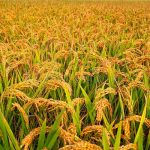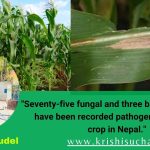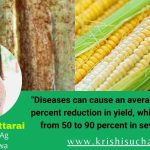Zero tillage practice of farming and it’s advantages

Introduction
Zero tillage farming, also known as No-till farming or direct drilling, is an agricultural technique for growing crops or pasture without disturbing the soil through tillage. The primary goal of no-till agriculture is to avoid cultivation of land and contribute in maintaining the soil structure. The idea of modern no-till farming started in the 1940s with Edward H. Faulkner, author of Plowman’s Folly. Researches have proven Zero tillage agricultural practices better for direct-seeded rice, maize, soybean, cotton, pigeon pea, mung bean, cluster bean, pearl millet during kharif season and wheat, barley, chickpea, mustard and lentil during rabi season. Land under no-till farming has increased across the world, which shows how this practice is being accepted rapidly among the farmers. In 1999, about 45 million ha was under no-till farming worldwide, which increased to 72 million ha in 2003 and to 111 million ha in 2009.
Zero tillage/No-Till Agriculture Practices
No-till farming methods suggest zero or the least soil disturbance. With conventional plowing, the top layer is turned over before seeding. There’s no doubt that tillage helps to aerate the soil, incorporate manure and fertilizers, loose the earth for future fragile seedling roots, to destroy pests, eradicate weeds. However, this agriculture technique strongly promotes soil erosion, removing the cover matter, causes an imbalance in micro-communities, and releases soil carbon into the air, contributing to the greenhouse effect. No-till agricultural practices include following activities:
- Minimal or no Tillage
No-till method of farming requires special equipment (disc seeders or agriculture drills) to make furrows, immediately plant seeds, firm them, and cover (unlike double-passing the field after plowing). This way, the soil suffers from minimum disturbance, as it is dug exactly where the seed is supposed to drop. Furthermore, planters allow the least fertilizer spends, applying them right into the furrow via designated tubes. Sometimes, no-till agriculture does involve minor or narrow tilling between the seasons if high yields generate a lot of manure and it composts poorly, inducing diseases or interferes with planter operations. - Surface Seeding
Surface seeding is the simplest method of ZT, involving the placement of seed onto the soil surface without any land preparation. Farmers in parts of eastern India, Bangladesh and Nepal commonly use this practice to establish legumes and oilseeds, and occasionally wheat. Wheat seed is broadcasted before or after rice harvest (relay planting). - Cover With Straw
Weed control is a major concern in no-till farming since weeds cannot be destroyed mechanically. To solve the problem, agriculturalists cover inter-rows with straw, dry hay, or mulches. It not only helps to suppress weeds due to lack of light but accumulates moisture and protects plant roots from the sun burn. - Crop Residue Management
Crop residue management is a year-round conservation tillage management system beginning with the selection of crops that produce sufficient residue. The system may include the use of cover crops after low residue producing crops. Crop residue management includes all field operations that affect residue amounts, orientation and distribution throughout the cropping system cycle. Retention of crop residues improves organic carbon content, water-stable aggregates, bulk density, hydraulic conductivity and soil biological activities. Residue management influences soil temperature, moisture conservation and weed and pest management. - Crop Rotation
Crop rotation is an efficient agricultural technique with multiple benefits. As a no-till method of farming, it addresses the following issues:
-weed infestations and pest invasions since different types of crops have different pest and weed threats;
-soil erosion as alternative plants have different roots;
-soil fertility owing to the property of legumes to release nitrogen. - Crop Monitoring
Crop Monitoring is an online tool for agriculture that greatly facilitates crop rotation decisions and no-till farming implementations in particular. It allows comprehensive monitoring and analysis of vegetation states in real time as well as the recent five years. Retrieving weather conditions in the light of several years along with data on vegetation indices, farmers can choose the most suitable crop with respect to the specific climatic needs of each plant. Simply put, they can opt for the most appropriate crop for a particular field.
Zero tillage farming in Nepal
It is practised in the tropical lowland districts of western Nepal where garlic is sown directly into the soil after the paddy is harvested. The seedbed is prepared by leaving a 3–5 cm thick layer of rice paddy crop residue on the soil surface after the paddy harvest. Garlic seed is planted directly into the soil soon after the paddy is harvested at a spacing of approximately 15 cm and the entire field is then covered with a 10 cm (or more) layer of hay. The seeds germinate with the help of the ambient moisture. The frequency and timing of irrigation depends on need, but since there has been no tillage and the ground is covered with mulch, much of the ambient moisture is retained in the soil. The mature garlic is harvested in February–March. This technology is gaining popularity because farmers can directly see the economic benefit of not having to till the soil.
Farmers, in Nepal, saved 10% human labor, 41.67% machinery labor and 25% seed amount in zero tillage (ZT) compared to Conventional tillage(CT) method. The net return of wheat was NRs. 54,255.5/ha in ZT and NRs. 39298/ha in CT method of wheat production. The benefit: cost ratio was found 2.38 in ZT compared to 1.83 in CT which is 23.64% more over CT method. Similarly, grain yield was found to be increased by 6.28% in ZT method. Farmers who had adopted ZT method of wheat cultivation were found interested for the continuation of this technology in future too.
Effect of Zero tillage on wheat cultivation
Wheat sowing after rice can be advanced by 10-12 days by adopting this technique compared to conventionally tilled wheat, and wheat yield reduction caused by late sowing can be avoided. ZT provides opportunity to escape wheat crop from terminal heat stress. Zero tillage reduces cost of cultivation by nearly Rs. 2,500-3,000/ha through reduction in cost of land preparation, and reduces diesel consumption by 50-60 litres per hectare. Zero tillage reduces water requirement of crop and the loss of organic carbon by oxidation. Zero tillage reduces Phalaris minor problem in wheat. The carbon status of soil is significantly enhanced in surface soil (0-5 cm), particularly under crop residue retention with zero tillage.
Soil response to zero tillage
- Reduce soil erosion: No-till agriculture reduces soil erosion. Tillage breaks the earth’s surface and turns it over, moving the cover layer inside. As a result, the bare soil is subject to erosion because of the loosened structure. Deprived of cover matter, it is subject to quick erosion due to water flows, especially in slope and steep areas, and winds. The rainsplash erosion is another issue to consider as flexible particles are easily removed when hit with heavy rains. Correspondingly, the absence of soil disturbance in no-till farming eliminates the issues.
- Soil Carbon Sequestration: No-till agriculture is essential for soil carbon sequestration. Tillage transfers soil carbon to the soil surface. Released carbon gives nutrients to plants, which is a good thing. However, it reacts with the atmosphere oxygen binding to carbon dioxide, which is a bad thing due to the greenhouse effect, so no-till farming carbon sequestration is a great advantage to consider. In the latter case, carbon remains in the ground. This is why no-till farming and the reduction of carbon dioxide closely relate.
- Conserve Soil fertility: No-till farming helps to conserve soil and preserve its fertility. Tilling interferes with the earth’s flora and fauna balance impacting micro-communities. It does help to control mature pests and their larvae mechanically; yet, it destroys beneficial species at the same time. With no-till, certain soil microorganisms in their natural habitats are capable of improving soil fertility with their activities. Another contribution of no-till agriculture to soil fertility is nitrogen enrichment by legumes, which is useful to subsequent crops in crop rotation.
Other general advantages of zero tillage practices are:
- Reduction in the crop duration and thereby early cropping can be obtained to get higher yields.
- Residual moisture can be effectively utilized and number of irrigations can be reduced.
- No tillage reduces the compaction of the soil and reduces the water loss by runoff and prevent soil erosion.
- As the soil is intact and no disturbance is done, No Till lands have more useful flora and fauna.
- Water retention- retains and increase the amount of water in the soil.
- Organic Matter increase- Plant remains are left on the soil surface to rot and add to the organic matter content in the soil.
- Cycling of nutrients- When the remains of the previous crops are left to rot and mix with soil, the nutrients they had accumulated is returned to the soil.
- Reduce Soil erosion- The minimum or no soil disturbance strengthens soil structure which resist movement of soil by rain water.
- Micro- Organism enhancement – The minimum soil disturbance ensures that the small organism in the soil thrive and multiply. Their activities of breakdown of materials in the soil is enhanced.
- Saves money – The reduced activities means money is saved on fuel, man power and hire/use of machinery. Reduction in the cost of inputs for land preparation and therefore a saving of around 80%.
- Faster Crop Maturity- the crops are planted immediately the rains are on which means they germinate and mature faster compared to systems where ploughing is done after the rains. More so because of the extra moisture the soil had.
- Soil Evaporation reduction- The organic matter and plant remains cover the soil ensuring no loss of soil moisture. If the rains are insufficient, the crop will continue growing due to the extra moisture.
- Easier Weeds control – after sowing, the weeds which germinate are easily controlled using a non-selective herbicide. After several years of the system, the soil cover increases reducing temperature in the soil. The weeds don’t grow except the planting line where soil will be exposed to the sun.
- Improved soil fertility – the activities of minimum soil disturbances, improved organic matter and enhanced soil matter improved soil fertility. This results in better crops for improved productions.
- Better profits- all the costs saved in the farm operations lower cost of production leading to increased profits.
- Environmentally safe – Greenhouse effect will get reduced due to carbon sequestration.
Conclusion
The natural resources are precious and therefore demand an effective and sustainable use. Zero tillage is a potential technology in this scenario. Although the drawback of use of non-selective herbicide is more, it still causes less effect than the conventional method of farming. In zero tillage, more returns can be achieved and timely crop can be grown with higher yields. Thus, farmers are slowly adapting this practice in Nepal too. Zero tillage can turn out to be an effective initiation towards conserving soil and let the healthy soil transfer to generations coming. Hence, it can be said as a technique to build a sustainable and progressive agricultural system.
Writer: Neetu Dey (Student, Bsc. Ag IAAS Paklihawa Campus)

 दिल्लीको होटलमा बसेर क्यानडा र अमेरिकामा मानव तस्करी
दिल्लीको होटलमा बसेर क्यानडा र अमेरिकामा मानव तस्करी  अनलाइन जुवा खेलाएर काभ्रेका अनिलले गरे दुई अर्बको कारोबार
अनलाइन जुवा खेलाएर काभ्रेका अनिलले गरे दुई अर्बको कारोबार  मुख्यमन्त्री सोडारीले विश्वासको मत लिन सुदूरपश्चिमको प्रदेश सभा बैठक आव्हान
मुख्यमन्त्री सोडारीले विश्वासको मत लिन सुदूरपश्चिमको प्रदेश सभा बैठक आव्हान  अफगानिस्तानमा बाढीबाट ३१५ भन्दा बढीको मृत्यु
अफगानिस्तानमा बाढीबाट ३१५ भन्दा बढीको मृत्यु  सुँगुरको मिर्गौला प्रत्यारोपण गरिएका रिचर्डको निधन
सुँगुरको मिर्गौला प्रत्यारोपण गरिएका रिचर्डको निधन 


